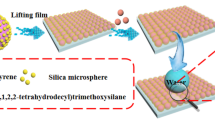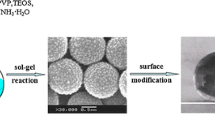Abstract
In this work, silica particles were firstly modified with poly(methyl methacrylate) and then converted to poly(methacrylic acid) (PMAA). The PMAA brushes with different molecular weight were used to modify the seed particles and learn the formation process of the raspberry-like particles. Silica particles with core–shell structure were obtained when the silica seed particles were modified only with carboxyl functional groups. With the increase of the molecular weight of PMAA brushes, uniform raspberry-like silica particles appeared gradually. But when the molecular weight of PMAA brushes was above 136,100, the morphologies became complicated. The electric charge of the polymer brushes was also found to have influence on the final morphologies of the particles. The contact angle (CA) tests showed that films composed of nanoparticles with uniform raspberry-like structures had an average CA of 157.2°, which indicated great prospects in the super-hydrophobic applications.






Similar content being viewed by others
References
Chaudhuri RG, Paria S (2012) Core/shell nanoparticles: classes, properties, synthesis mechanisms, characterization, and applications. Chem Rev 112(4):2373–2433. doi:10.1021/Cr100449n
Slowing II, Vivero-Escoto JL, Wu CW, Lin VSY (2008) Mesoporous silica nanoparticles as controlled release drug delivery and gene transfection carriers. Adv Drug Deliver Rev 60(11):1278–1288. doi:10.1016/j.addr.2008.03.012
Zhu YF, Shi JL, Shen WH, Dong XP, Feng JW, Ruan ML, Li YS (2005) Stimuli-responsive controlled drug release from a hollow mesoporous silica sphere/polyelectrolyte multilayer core-shell structure. Angew Chem Int Edit 44(32):5083–5087. doi:10.1002/anie.200501500
Dechezelles JF, Malik V, Crassous JJ, Schurtenberger P (2013) Hybrid raspberry microgels with tunable thermoresponsive behavior. Soft Matter 9(10):2798–2802. doi:10.1039/C3sm27433k
Song LY, Lin CL, Wang L, Sheng HL, Zhou YF, Nie WY (2011) Fabrication of teardrop-shaped silica particles in polyelectrolyte diluted solution through in situ sol-gel process. J Sol-Gel Sci Techn 58(3):651–655. doi:10.1007/s10971-011-2440-9
Zhai L, Cebeci FC, Cohen RE, Rubner MF (2004) Stable superhydrophobic coatings from polyelectrolyte multilayers. Nano Lett 4(7):1349–1353. doi:10.1021/Nl049463j
Wang Y, Angelatos AS, Caruso F (2008) Template synthesis of nanostructured materials via layer-by-layer assembly. Chem Mater 20(3):848–858. doi:10.1021/Cm7024813
Parvole J, Chaduc I, Ako K, Spalla O, Thill A, Ravaine S, Duguet E, Lansalot M, Bourgeat-Lami E (2012) Efficient synthesis of snowman- and dumbbell-like silica/polymer anisotropic heterodimers through emulsion polymerization using a surface-anchored cationic initiator. Macromolecules 45(17):7009–7018. doi:10.1021/Ma301355g
Agrawal M, Gupta S, Stamm M (2011) Recent developments in fabrication and applications of colloid based composite particles. J Mater Chem 21(3):615–627. doi:10.1039/C0jm02631j
Li YX, Pan YF, Zhu LL, Wang ZQ, Su DM, Xue G (2011) Facile and controlled fabrication of functional gold nanoparticle-coated polystyrene composite particle. Macromol Rapid Comm 32(21):1741–1747. doi:10.1002/marc.201100377
Ming W, Wu D, van Benthem R, de With G (2005) Superhydrophobic films from raspberry-like particles. Nano Lett 5(11):2298–2301. doi:10.1021/Nl0517363
Tsai HJ, Lee YL (2007) Facile method to fabricate raspberry-like particulate films for superhydrophobic surfaces. Langmuir ACS J Surf Colloid 23(25):12687–12692. doi:10.1021/La702521u
Qian Z, Zhang ZC, Song LY, Liu HR (2009) A novel approach to raspberry-like particles for superhydrophobic materials. J Mater Chem 19(9):1297–1304. doi:10.1039/B810808k
D’Acunzi M, Mammen L, Singh M, Deng X, Roth M, Auernhammer GK, Butt HJ, Vollmer D (2010) Superhydrophobic surfaces by hybrid raspberry-like particles. Faraday Discuss 146:35–48. doi:10.1039/B925676h
Liu XM, He JH (2007) Hierarchically structured superhydrophilic coatings fabricated by self-assembling raspberry-like silica nanospheres. J Colloid Interface Sci 314(1):341–345. doi:10.1016/j.jcis.2007.05.011
Du X, Liu XM, Chen HM, He JH (2009) Facile fabrication of raspberry-like composite nanoparticles and their application as building blocks for constructing superhydrophilic coatings. J Phys Chem C 113(21):9063–9070. doi:10.1021/Jp9016344
Yao TJ, Wang CX, Lin Q, Li X, Chen XL, Wu J, Zhang JH, Yu K, Yang B (2009) Fabrication of flexible superhydrophobic films by lift-up soft-lithography and decoration with Ag nanoparticles. Nanotechnology 20 (6). doi:10.1088/0957-4484/20/6/065304
Tsai PS, Yang YM, Lee YL (2007) Hierarchically structured superhydrophobic coatings fabricated by successive Langmuir-Blodgett deposition of micro-/nano-sized particles and surface silanization. Nanotechnology 18 (46). doi:10.1088/0957-4484/18/46/465604
Li GL, Yang XL, Wang JY (2008) Raspberry-like polymer composite particles via electrostatic heterocoagulation. Colloid Surf A 322(1–3):192–198. doi:10.1016/j.colsurfa.2008.03.006
Zhang YH, Chen H, Zou QC (2009) Anionic surfactant for silica-coated polystyrene composite microspheres prepared with miniemulsion polymerization. Colloid Polym Sci 287(10):1221–1227. doi:10.1007/s00396-009-2089-x
Puretskiy N, Ionov L (2011) Synthesis of Robust raspberry-like particles using polymer brushes. Langmuir ACS J Surf Colloid 27(6):3006–3011. doi:10.1021/La104614t
Wang JY, Yang XF (2008) Synthesis of core-corona polymer hybrids with a raspberry-like structure by the heterocoagulated pyridinium reaction. Langmuir ACS J Surf Colloid 24(7):3358–3364. doi:10.1021/La7036394
Cai Y, Xie H, Sun J, Liu H, Wang J, Zhou Y, Nie W, Song L (2013) Weak acid–base interaction induced assembly for the formation of berry-like polystyrene/SiO2 composite particles. Mater Chem Phys 137(3):796–801. doi:10.1016/j.matchemphys.2012.09.069
Zhang K, Ma J, Zhang B, Zhao S, Li YP, Xu YX, Yu WZ, Wang JY (2007) Synthesis of thermoresponsive silica nanoparticle/PNIPAM hybrids by aqueous surface-initiated atom transfer radical polymerization. Mater Lett 61(4–5):949–952. doi:10.1016/j.matlet.2006.06.021
Zhang K, Li HT, Zhang HW, Zhao S, Wang D, Wang JY (2006) Surface-initiated atom transfer radical polymerization on spherical silicon gel in water-borne system at ambient temperature. Mater Chem Phys 96(2–3):477–482. doi:10.1016/j.matchemphys.2005.07.070
Stöber W, Fink A, Bohn E (1968) Controlled growth of monodisperse silica spheres in the micron size range. J Colloid Interface Sci 26(1):62–69
Agrawal M, Pich A, Gupta S, Zafeiropoulos NE, Simon P, Stamm M (2008) Synthesis of novel tantalum oxide sub-micrometer hollow spheres with tailored shell thickness. Langmuir ACS J Surf Colloid 24(3):1013–1018. doi:10.1021/La702509j
Sun TL, Feng L, Gao XF, Jiang L (2005) Bioinspired surfaces with special wettability. Accounts Chem Res 38(8):644–652. doi:10.1021/Ar040224c
Acknowledgments
This work was financed by the National Natural Science Foundation of China (Grant No. 51303001), Anhui Provincial Natural Science Foundation (1408085ME86), Scientific Research Fund of Anhui Provincial Education Department (KJ2013A014), Startup Foundation for Doctors of Anhui University, Postdoctoral Science Foundation of China (01001419) and the 211 Project of Anhui University.
Author information
Authors and Affiliations
Corresponding authors
Rights and permissions
About this article
Cite this article
Liu, Y., Zhou, Y., Nie, W. et al. Formation and surface properties of raspberry-like silica particles: effect of molecular weight of the coating poly(methacrylic acid) brushes. J Sol-Gel Sci Technol 72, 122–129 (2014). https://doi.org/10.1007/s10971-014-3434-1
Received:
Accepted:
Published:
Issue Date:
DOI: https://doi.org/10.1007/s10971-014-3434-1




